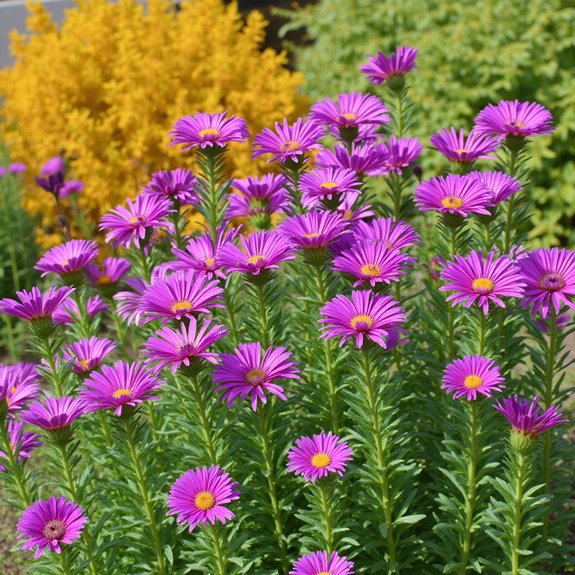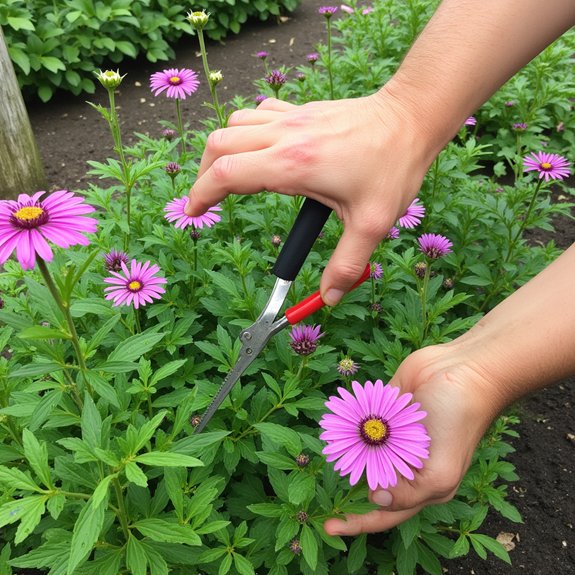Asters transform autumn gardens into vibrant displays of purple, pink, and white blooms, yet many gardeners struggle with their seemingly finicky nature. These hardy perennials actually thrive with surprisingly simple care techniques, once growers understand their specific needs. The secret lies in mastering three essential timing windows that determine whether plants produce abundant flowers or disappointing, sparse growth. Most gardening guides overlook these vital periods entirely.
Contents
- 1 Understanding Asters: Star-Shaped Perennials for Fall Gardens
- 2 Propagation Techniques: Seeds, Cuttings, and Division Methods
- 3 Planting Requirements: Spacing, Timing, and Site Selection
- 4 Soil Preparation and Growing Conditions for Optimal Growth
- 5 Essential Maintenance Practices for Healthy Aster Plants
- 6 Common Pests and Disease Management Strategies
- 7 Creative Uses and Companion Planting With Asters
- 8 Seasonal Care and Long-Term Garden Success
Understanding Asters: Star-Shaped Perennials for Fall Gardens

Starbursts of color emerge in autumn gardens when most other perennials have faded, making asters the dependable champions of fall landscapes. These star-shaped flowers, whose name derives from Ancient Greek meaning “star,” bloom reliably from late summer through early fall in shades ranging from soft blues and purples to vibrant reds.
Aster varieties span over 180 species after recent botanical reclassification, offering options from compact ground covers to towering backdrop plants. Beyond their practical garden value, aster symbolism represents patience and elegance, fitting attributes for flowers that wait until season’s end to shine brightest when pollinators need them most.
Propagation Techniques: Seeds, Cuttings, and Division Methods
Three distinct propagation methods give gardeners complete control over expanding their aster collections, each offering unique advantages depending on timing and desired outcomes. Seed selection allows complete growing control, starting indoors in late winter using pre-moistened medium. Cutting techniques involve taking 4-inch stems with lower leaves removed, using clean shears and optional rooting hormone for enhanced growth. Division timing proves essential, with early spring providing ideal conditions for rejuvenating established plants every few years. Each method requires specific knowledge of species requirements, but proper execution guarantees propagation success while maintaining cultivar characteristics and promoting healthy plant development.
Planting Requirements: Spacing, Timing, and Site Selection

Once propagation succeeds, gardeners must focus on proper placement to guarantee their new asters thrive throughout the growing season. Spacing approximately two feet between plants prevents overcrowding and promotes healthy airflow. Light requirements demand full sun exposure for maximum flowering potential, though some varieties tolerate partial shade. Planting depth should match the root ball’s original level, avoiding burial of stems. Timing matters greatly: transplant seedlings outdoors after final frost passes in early spring. Site selection requires well-draining, slightly acidic loamy soil enriched with compost. Poor drainage leads to root rot, while sandy soil dries too quickly for ideal growth.
Soil Preparation and Growing Conditions for Optimal Growth
Although proper site selection establishes the foundation, soil preparation determines whether asters will merely survive or truly flourish in their new environment. These perennials prefer slightly acidic, loamy soil with excellent drainage yet consistent moisture retention. Test soil pH before planting, aiming for 6.0 to 7.0 for ideal nutrient uptake.
Poor soil requires amendment with compost to boost nutrients and improve structure. Avoid sandy soils that drain too quickly, leaving roots stressed during dry periods. For containers, use high-quality potting mix enhanced with coconut coir, which improves drainage without compromising moisture retention. Well-prepared soil rewards gardeners with vigorous growth.
Essential Maintenance Practices for Healthy Aster Plants

While established asters appear self-sufficient, regular maintenance practices make the difference between struggling plants and spectacular fall displays. A consistent watering schedule keeps soil moist but not waterlogged, particularly during dry spells. Deep weekly watering works better than frequent shallow sessions.
Fertilizer application should occur sparingly, as asters prefer lean soil. Apply balanced fertilizer once in early spring, avoiding high-nitrogen options that promote excessive foliage over blooms. Pinch growing tips in early summer to encourage bushier growth and more flowers. Remove spent blooms regularly to extend flowering periods and maintain plant energy.
Common Pests and Disease Management Strategies
Several common pests and diseases can threaten aster health, but early identification makes management straightforward and effective. Mealybugs cluster on stems, while aphids gather on new growth—both removable by hand or treatable with horticultural oil. For slugs and snails, beer traps work remarkably well.
Disease prevention starts with proper spacing for airflow. Powdery mildew and rust affect foliage when conditions stay damp, so water at soil level rather than overhead. Leaf spot and stem canker require immediate action—prune affected areas and dispose of debris completely. Keep foliage dry, remove fallen leaves regularly, and monitor plants weekly for early pest identification.
Creative Uses and Companion Planting With Asters
Beyond protecting asters from threats, gardeners can maximize their impact through strategic placement and thoughtful companion choices. Shorter varieties excel as filler plants in mixed plantings, creating stunning color combinations with mums and goldenrod. Tall asters provide dramatic backdrops when paired with ornamental grasses or black-eyed Susans. These companion flowers enhance garden aesthetics while supporting pollinator attraction during fall months. Mass planting creates vibrant carpets perfect for seasonal arrangements. Late-blooming asters extend color after spring perennials fade, making them invaluable for continuous displays. Their star-shaped blooms complement both cottage garden styles and modern landscape designs effectively.
Seasonal Care and Long-Term Garden Success
Four distinct seasons demand specific aster care strategies to guarantee robust growth year after year. Spring requires division every three years, removing weak sections while replanting healthy clumps 2 feet apart. Summer maintenance involves consistent watering and deadheading spent blooms to encourage continued flowering. Fall brings seasonal pruning after first frost, cutting stems to 3-4 inches above ground level. Winter protection becomes vital in harsh climates, applying 4-inch mulch layers around plant bases. Container-grown asters need relocation to unheated garages or wrapped pots for insulation. This cyclical approach guarantees vigorous spring emergence and maintains flowering consistency across multiple growing seasons.
